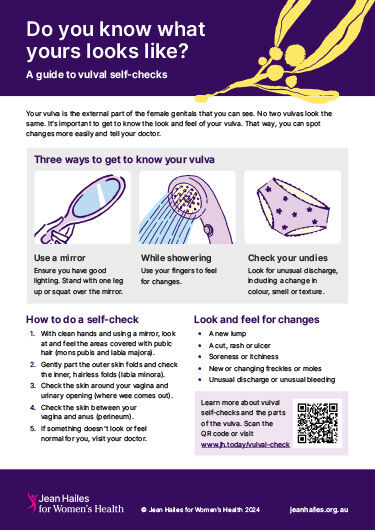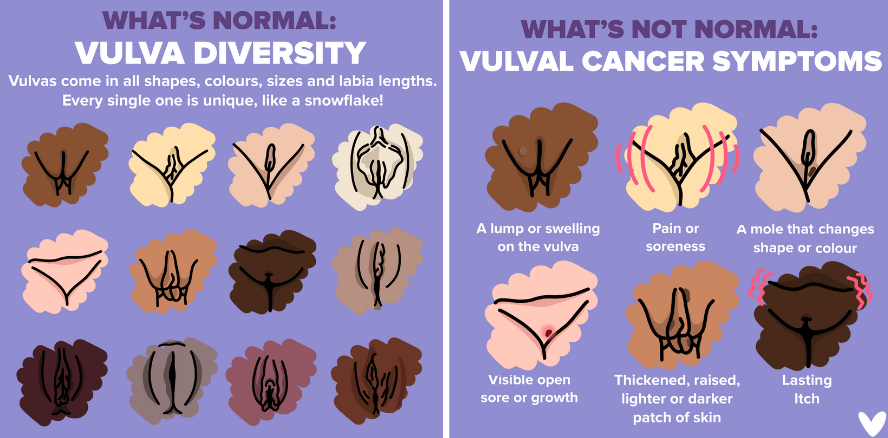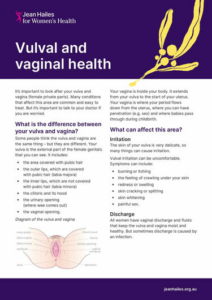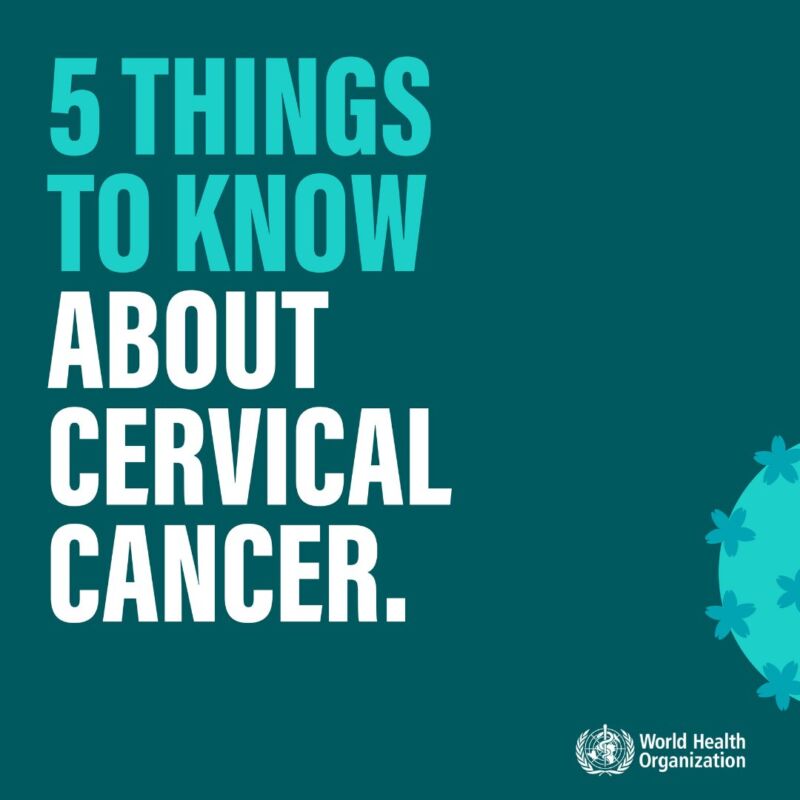“‘Vulvodynia’ is the medical term for chronic pain
or discomfort in the vulva
that lasts for at least 3 months”.1
Umbrella
What may the Vulvodynia Umbrella include?
Depending on the Source (DotS) this Umbrella may include:
- Burning Vulva Syndrome
- Dysaesthetic/Dysesthetic Vulvodynia
- Essential Vulvodynia
- Generalized Unprovoked Vulvodynia
- Generalized Vulvodynia
- Localised Provoked Vulvar Pain
- Localised Vulvodynia
- Neuroproliferative Vestibulodynia
- Pudendal Neuralgia
- Provoked Vulvodynia
- Superficial Dyspareunia
- Unprovoked Vulvodynia
- Vestibulitis
- Vestibulodynia
- Vulval Pain
- Vulvar Vestibulitis Syndrome (VVS)
- Vulvodynia
Vulva
What is the vulva?
DotS the definition of the vulva may vary. In Vulval Irritation the (Australian) Jean Hailes for Women’s Health’s (JH) definition is:
Vulval Pain
What is vulval pain?
DotS the definition of vulval pain may vary. In Medical Advice: Vulval Pain – What Is Vulvodynia? Caredownthere.com.au explain:
Vulvodynia is also known as the “burning vulva syndrome””.3
Vulvodynia
What is vulvodynia?
DotS the definition of the vulvodynia may vary. In Vulvodynia (Vulval Pain) the (United Kingdom) NHS’s definition is:
In Vulval and Vaginal Pain: Vulvodynia the JH’s definition is:
In What Is Vulvodynia? [+ Diagrams] the (United States) National Vulvodynia Association’s (NVA) definition is:
 “Vulvodynia, simply put, is chronic vulvar pain without an identifiable cause. The location, constancy and severity of the pain vary among sufferers. Some women experience pain in only one area of the vulva, while others experience pain in multiple areas. The most commonly reported symptom is burning, but women’s descriptions of the pain vary. One woman reported her pain felt like “acid being poured on my skin,” while another described it as “constant knife-like pain””.6
“Vulvodynia, simply put, is chronic vulvar pain without an identifiable cause. The location, constancy and severity of the pain vary among sufferers. Some women experience pain in only one area of the vulva, while others experience pain in multiple areas. The most commonly reported symptom is burning, but women’s descriptions of the pain vary. One woman reported her pain felt like “acid being poured on my skin,” while another described it as “constant knife-like pain””.6Localised Vulvodynia
What is localised vulvodynia?
DotS the definition of localised vulvodynia may vary. In What Is Vulvodynia? What Is Localised Vulvodynia? [+ Diagrams] the NVA’s definition is:
Provoked Vulvodynia (Vestibulodynia)
What is provoked vulvodynia?
DotS the definition of provoked vulvodynia may vary. In What Is Vulvodynia? What Is Localized Vulvodynia? [+ Diagrams] the NVA explain:
- Sexual intercourse
- Tampon insertion
- A gynecologic examination
- Prolonged sitting and/or
- Wearing fitted pants”.8
Generalized Vulvodynia
What is generalized vulvodynia?
DotS the definition of generalized vulvodynia may vary. In What Is Vulvodynia? What Is Generalized Vulvodynia? [+ Diagrams] the NVA’s definition is:
Activities that apply pressure to the vulva, such as prolonged sitting or sexual intercourse, typically exacerbate symptoms”.9
Duration
How long may vulvodynia symptoms last?
In Vulvodynia: Symptoms & Causes – Overview the (United States) Mayo Clinic explain:
Cause
What causes vulvodynia?
In Vulvodynia: Symptoms and Causes – What Causes Vulvodynia? the (United States) Cleveland Clinic also note:
- Inflammation
- Hormonal factors
- Genetic (inherited) factors
- Injury to your nerves (neuropathic problems)
- Long-term reactions to past vaginal infections
- Weakened pelvic floor muscles or muscle spasms
- Irritation from harsh products that touch your skin”.11
Common or Not
How common is vulvodynia?
In Vulval Pain: Vulvodynia the JH note:
Health Care Provider
What if I think I have vulvodynia?
If you think you have vulvodynia, it may be in your best interest to choose to talk to your health care provider about this. The Mayo Clinic explain:
- An active infection from yeast or bacteria
- A sexually transmitted disease such as herpes
- An inflammatory skin condition
- Vulvar growths
- Genitourinary syndrome of menopause”.13
In Vulvodynia: Frequently Asked Questions – A Note From Cleveland Clinic the Cleveland Clinic also encourage us to seek help:
Health Topics A-Z
Where may I find Health Topics A-Z related to the Vulvodynia?
In Health Topics A-Z you may find:
Links
Where may I find Links related to Vulvodynia?
Your Country may have Links similar to:
Links
This Links List to third party websites is neither comprehensive nor exhaustive. Inclusion on this Links List does not imply endorsement or recommendation. Non-inclusion on this Links List does not imply non-endorsement or non-recommendation. Third party websites are not under the control of Meno Martha International Menopause Directory. Third party websites may contain explicit medical images and/or sexual references. Please read Meno Martha International Menopause Directory’s Links Policy before proceeding to a Link. Please contact Webmaster if you experience a problem with a Link.New or Updated
- About the Vulva and Vagina [06 June 2025]
- The Vulva & Vagina Explained: Sex Ed #2 [April 2025]
- They are not bad words! (Campaign Theme Song) [22 August 2025]
- Vulval and Vaginal Pain [17 June 2025]
- Vulval and Vaginal Conditions [17 June 2025]
- Vulvodynia Q&A | Causes, Flare-Ups, and Pain Relief Tips – Prof. Marc Possover [14 August 2025]
- A Guide To Vulval Self-Checks [+ Video]

- About the Vulva and Vagina
- Australian and New Zealand Vulvovaginal Society: Patient Information
- Australian and New Zealand Vulvovaginal Society: Patient Information – Vulval Anatomy
- Australian and New Zealand Vulvovaginal Society: Patient Information – Vulvovaginal Pain
- Caredownthere.com.au
- Checking Your Vulva: What To Look Out For

- Consumer Video and Podcast Series: 20223 Consumer Videos and Podcasts – Discussing Sexual Health Concerns With Your Health Care Professional
- Consumer Video and Podcast Series: 2024 Consumer Videos and Podcasts – Preparing for Your Menopause Health Care Visit
- Definition and Types of Vulvodynia
- Diagnosis
- Diagnosis and Management of Vulvodynia In Postmenopausal Women
- Differentiating Overlapping Symptoms of Vulvodynia and Pudendal Neuralgia
- Essential Information: Caring for Your Skin Down There
- Essential Information: See Your Doctor If
- Essential Information: Some Facts About the Vulva
- FAQs: Disorders of the Vulva: Common Causes of Vulvar Pain, Burning, and Itching
- FAQs: Vulvodynia
- FAQs: Vulvovaginal Health
- Genitourinary Syndrome of Menopause
- Genitourinary Syndrome of Menopause
- International Society for the Study of Vulvovaginal Diseases: Patient Handouts
- International Society for the Study of Women’s Sexual Health
- International Society for the Study of Women’s Sexual Health: Find A Provider
- Later Years (Around 50 Years and Over): Menopause and Post Menopause Health – Sexual Wellbeing, Intimacy and Menopause [+ Video: Menopause Is the End of Your Sex Life] [Other Languages and Formats]
- Let’s Talk About Vulvas
- Medical Advice: Medical Exams
- Medical Advice: Vulval Pain
- National Vulvodynia Association
- National Vulvodynia Association: For Patients – How NVA Can Help You
- National Vulvodynia Association: Other Resources
- National Vulvodynia Association: Patient Booklets
- Neuroproliferative Vestibulodynia
- Painful Intercourse (Dyspareunia)
- Pelvic Exam
- Pelvicpain.org.uk [Pelvic Pain Support Network, United Kingdom]
- Perimenopause and Menopause Symptom Checklist
- Prosayla Supported By ISSWSH [International Society for the Study of Women’s Sexual Health]
- Pudendal Nerve Entrapment
- Pudendal Neuralgia
- Self-Help Tips
- Sex and Sexual Health
- The Vulva & Vagina Explained: Sex Ed #2
- They are not bad words! (Campaign Theme Song)
- Vaginal and Vulval Pain: Know the Different Causes and When To Seek Help
- Vaginismus
- Vaginismus
- Videos & Podcasts: Videos – Vulvar Diseases, Overview for Aging Women
- Vulva and Vagina
 Vulval Irritation
Vulval Irritation- Vulval Pain
- Vulval Pain, Vulvar Vestibulitis Syndrome (VVVS)
- Vulval and Vaginal Conditions
- Vulval and Vaginal Health
- Vulval and Vaginal Pain
- Vulval and Vaginal Pain: Vulvodynia
- Vulvar Anatomy
- Vulvar Awareness Campaign Season 2024 – 2025

- Vulvodynia
- Vulvodynia
- Vulvodynia (Vulval Pain)
- Vulvodynia Treatments
- Vulvodynia: Diagnosis & Treatment
- Vulvodynia: Diagnosis and Tests
- Vulvodynia: Management and Treatment
- Vulvodynia: Symptoms & Causes
- Vulvodynia: Symptoms & Causes – Alternative Medicine
- Vulvodynia: Symptoms & Causes – Lifestyle and Home Remedies
- Vulvodynia: Symptoms and Causes
- Vulvovaginal Atrophy
- Webinars: Previous – Pay Attention on Your Way In! The Vulva Is An Important Organ Too
- What Causes Vulvodynia?
- What Is Vulvodynia? [+ Diagrams]
- What’s Normal: What Is Normal Vulval & Vaginal Anatomy?
- When Sex Hurts – Podcast [Vaginismus and Vulvodynia]
Sources
Where may I find the Sources quoted?
You may find the Sources quoted:
Sources
- Vulval and Vaginal Pain: Vulvodynia. Last Updated: 17 June 2025 | Last Reviewed: 02 June 2025. Jean Hailes for Women’s Health https://www.jeanhailes.org.au/health-a-z/vulva-vagina/vaginal-pain Accessed: 29 August 2025
- Vulval Irritation. Last Updated: 17 June 2025 | Last Reviewed: 02 June 2025. Jean Hailes for Women’s Health https://www.jeanhailes.org.au/health-a-z/vulva-vagina/vulval-irritation Accessed: 29 August 2025
- Medical Advice: Vulval Pain – What Is Vulvodynia? Caredownthere.com.au https://www.caredownthere.com.au/_pages/advice.html Accessed: 29 August 2025
- Vulvodynia (Vulval Pain). Page Last Reviewed: 16 January 2024. NHS https://www.nhs.uk/conditions/vulvodynia/ Accessed: 29 August 2025
- Vulval and Vaginal Pain: Vulvodynia. Last Updated: 17 June 2025 | Last Reviewed: 02 June 2025. Jean Hailes for Women’s Health https://www.jeanhailes.org.au/health-a-z/vulva-vagina/vaginal-pain Accessed: 29 August 2025
- What Is Vulvodynia? National Vulvodynia Association https://www.nva.org/whatIsVulvodynia.html Accessed: 29 August 2025
- What Is Vulvodynia? What Is Localized Vulvodynia? National Vulvodynia Association https://www.nva.org/whatIsVulvodynia.html Accessed: 29 August 2025
- What Is Vulvodynia? What Is Localized Vulvodynia? National Vulvodynia Association https://www.nva.org/whatIsVulvodynia.html Accessed: 29 August 2025
- What Is Vulvodynia? What Is Generalized Vulvodynia? National Vulvodynia Association https://www.nva.org/whatIsVulvodynia.html Accessed: 29 August 2025
- Vulvodynia: Symptoms & Causes – Overview. 01 September 2023. Mayo Clinic https://www.mayoclinic.org/diseases-conditions/vulvodynia/symptoms-causes/syc-20353423 Accessed: 29 August 2025
- Vulvodynia: Symptoms and Causes – What Causes Vulvodynia? Last Reviewed: 27 December 2022. Cleveland Clinic https://my.clevelandclinic.org/health/diseases/17878-vulvodynia Accessed: 29 August 2025
- Vulval and Vaginal Pain: Vulvodynia. Last Updated: 17 June 2025 | Last Reviewed: 02 June 2025. Jean Hailes for Women’s Health https://www.jeanhailes.org.au/health-a-z/vulva-vagina/vaginal-pain Accessed: 29 August 2025
- Vulvodynia: Symptoms & Causes – Overview. 01 September 2023. Mayo Clinic https://www.mayoclinic.org/diseases-conditions/vulvodynia/symptoms-causes/syc-20353423 Accessed: 29 August 2025
- Vulvodynia: Frequently Asked Questions – A Note From Cleveland Clinic. Last Reviewed: 27 December 2022. Cleveland Clinic https://my.clevelandclinic.org/health/diseases/17878-vulvodynia Accessed: 29 August 2025







